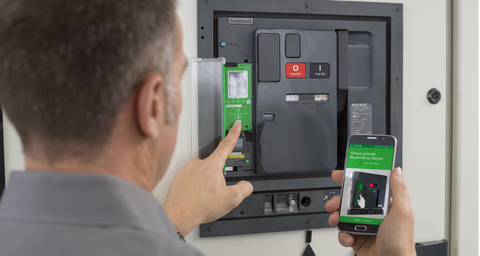Data and efficiency go hand in hand as businesses are looking for new ways to streamline their operations. Daniel Tovey explains how the humble circuit breaker could soon become an invaluable asset for clients to monitor their critical systems. Smart power distribution systems are here, but what does this mean for electrical and other engineering contractors?

In this article, I will provide a brief overview of what a smart circuit breaker is and suggest how smart power distribution systems could change the way that contractors work with their clients.
Throughout 2018, digitalisation will continue to have a growing impact on how clients run their businesses. In a competitive environment, success is determined by an organisation’s ability to optimise its workflow and respond swiftly when faced with challenges and disruption. These levels of efficiency and immediacy are achieved by harnessing Big Data. By analysing the data related to ongoing processes and operations, the company can make reliable, informed decisions on how to improve in the future.
The running cost and operational ability of their buildings are not exempt from these deductions. In fact, recent advances in power distribution are providing your clients with the means to monitor a system in real-time and optimise performance.
This technology opens up a unique opportunity for forward-thinking electrical contractors to provide the necessary infrastructure. But what does a smart power distribution system look like?
What is a smart circuit breaker?
On the surface, a smart power distribution system appears similar to a traditional system, where devices manage the flow of power. However, by embedding sensors and giving devices the ability to communicate with the cloud and with each other, you provide the ability manage the flow of data as well.
Take a circuit breaker for example. A traditional breaker is designed to automatically interrupt an electric circuit when it detects excessive current. Its role is to protect the system from overloads, short circuits and insulation failure. A smart circuit breaker will not only protect the system, it will also include advanced functionality, wireless connectivity and metering capabilities. This will allow the smart breaker to be monitored and controlled remotely, provide real-time feedback on any connected assets, notifying operators of any overloads or other potential faults.
This added functionality also gives the device the ability to integrate with the rest of the system and communicate data wirelessly that sets it apart. The Emax2 circuit breaker from ABB, for example, can communicate with the ABB Ability cloud computing platform, ABB Ability Electrical Distribution Control System. Likewise, the Masterpact MTZ from Schneider Electric will communicate with the company’s EcoStruxure platform.
With devices like smart circuit breakers integrating with other sensors, actuators and meters throughout the building, you form a digital architecture or ecosystem which that provides operators with a full, real-time overview of the power situation throughout a facility.
What are the benefits of a smart power distribution system?
The benefits of a smart power distribution system are obvious when you consider a manufacturing facility, a bank or hospital. Operational downtime in these environments can be costly and even fatal. Smart circuit breakers provide a simple way of adding an extra element of control and protection to critical systems. They can also gather and feedback data in real time, so operators can monitor and optimise performance over time and respond to faults as they happen – or even avoid them altogether!
As well as providing new levels of reliability and intelligence to your client’s building a smart power distribution system installation can also offer additional commercial benefits for the contractor.
Providing these solutions can open the possibility for long-term service opportunities. By installing the architecture, you will be the expert in place to help fix any problems and inefficiencies that the system flags up. It is an opportunity to form partnerships with your clients so, when their energy efficiency and performance requirements change, you are the contractor they rely on to upscale and update the system and ensure the solution is fit for purpose.
How can I provide a smart power distribution system?
Modern buildings provide a new host of challenges when it comes to electrical distribution design. Where designers have always prioritised fault protection and continuity of supply, they now must also factor in energy efficiency and data connectivity.
Understanding the changing demands of your clients, and their increasing reliance on data means it is important to get to know new technologies and services that can help future-proof their systems.
If you want access to these solutions, your best bet is to approach the manufacturers directly. For example, companies that wish to provide Schneider Electric’s next generation EcoStruxure smart power distribution architecture to clients can join the EcoExpert Partnership programme. This will provide you with the training and support to confidently commission the solution.
Reliable digital infrastructures and rich data insights have never been so valuable to your clients. With a bit of training, the smart circuit breaker could help you become the contractor that can help take their business to the next level.